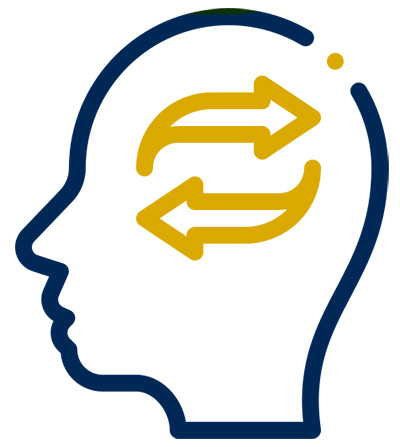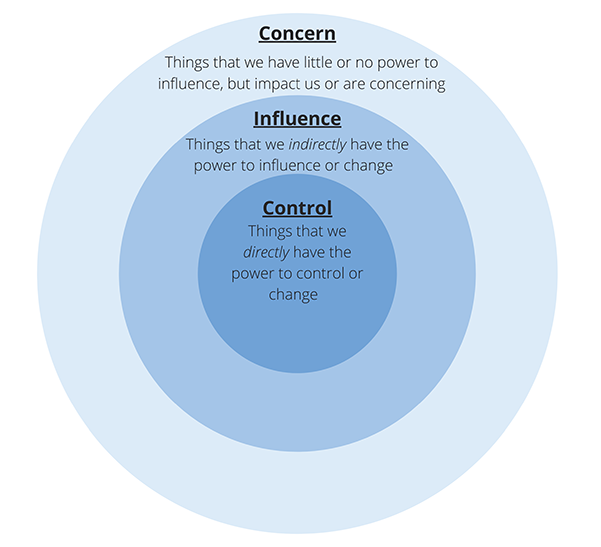 Welcome back to April’s blog series on navigating change. To better understand how change can impact us, make sure you check out last week’s post on Understanding Change . This week we will discuss an exercise you can do to identify what is in your control and what you should be focusing on to navigate change productively.
Welcome back to April’s blog series on navigating change. To better understand how change can impact us, make sure you check out last week’s post on Understanding Change . This week we will discuss an exercise you can do to identify what is in your control and what you should be focusing on to navigate change productively.
The exercise is to complete your Circle of Control, Influence and Concern through the five steps below. For a handy worksheet on this, email me at lwiesner@ucmerced.edu and I will send you my own fillable PDF version for your convenience.
First, a couple of definitions:
- Circle of Control: Things we have direct control over or power to change.
- Circle of Influence: Things we indirectly have power over or influence to change.
- Circle of Concern: Things we have little to no power to control or influence, BUT they are impacting to us or concerning to us.
Step 1: Narrow your focus
Write down the topic of the exercise to keep you on track. For example, let’s say our department is going through a reorganization. Focus your brainstorming on that topic. It can be easy to get distracted with other issues that are concerning to you like national and local politics, family dynamics or the state of the world. You can use this exercise for those issues as well, but stay focused on the topic you want to explore to give you a better understanding of the issue.
Step 2: Start with your Circle of Concern
Always start with the Circle of Concern. These are the things that, when we stay focused on them, cause us stress, anxiety and hopelessness. We start with this level because it is usually what is on our mind and if we don’t put it down on paper at the start, it can distract us in the inner circles of influence and control. To do this, list all the things you don’t have control of influence over. In the reorg example above, we may put down items like decisions of leadership, the external factors that may have led to this decision, or the information that is shared with us. We don’t have control over any of these items, but they impact us.

Step 3: Move to your Circle of Influence
What do you have some influence over on the topic? In the reorg example, we might identify that we have influence over our communication and relationship with our direct supervisor, our reputation at work or our teamwork and collaboration with our immediate team. These are things that involve other people, so we don’t have complete control over them, but we do play a part and have some influence on these relationships and communications.
Step 4: Focus on your Circle of Control
Now really start exploring all the things you have control over. Categorically, these items are typically going to be related to our words and communication, our thoughts and actions, our mood and work ethic, and our decisions. In the reorg example, we might identify things in our Circle of Control being giving feedback to our supervisor about how the change is impacting us or deciding how we can communicate our needs in a professional and respectful manner. Focusing on what we have control over gives us an understanding of what choices, decisions and communications we can make to better navigate the change.
Step 5: Review and reflect
- Make sure you complete this step, as it may be the most important part of this process. Take a step back and look at your responses and reflect on the following questions:
- How can I increase what I have influence over?
- (e.g., work to get a promotion so you can be involved in these decisions, enlist the support of others who have more influence than you).
- How can I minimize the impacts of the items in my circle of concern on me?
- (e.g., stress management techniques, being mindful of focusing on your circle of control).
- How can I stay focused on the things I am in control over?
- What are my alternative actions that I might not be seeing?
In general, we don’t resist change, but we often resist being changed. This exercise can help us find our own power in a situation that may be or seem to be out of our control. This exercise may look different from situation to situation and person to person and is certainly not a magic wand that will make the unwanted change go away. But it may help us see what our choices are to be able to navigate the change effectively and productively.
Stay tuned for the next two weeks as we continue to build on the topic of navigating change.
Luke Wiesner is the UC Merced Conflict Resolution Coach , a private resource for staff members who are interested in having a partner to support workplace challenges or conflicts. This service is voluntary, and you can partner with the coach by yourself or with fellow university employees.




